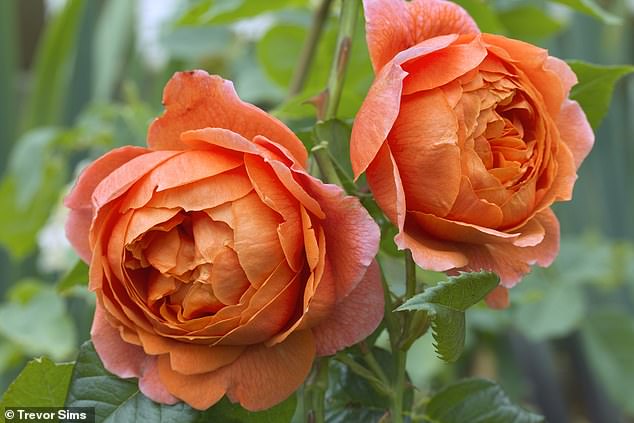A rosy outlook at last: Heatwaves can help maintain a vibrant display all the way through till autumn
- Nigel Colborn shared his advice for vibrant displays of roses for months to come
- British gardening expert said productive varieties will flower until mid November
- Recommends picking off faded blooms so they don’t spoil newly opening buds
We’re having a vintage year for roses. The mild winter followed by an April heatwave pushed them into bud more than a month early.
Spring drought was a setback, but heavy rain soon restored growth. That resulted in a magnificent and sustained summer display.
That main summer flush is now over. But roses are far from finished and the best will flower in smaller flushes for months to come. With favourable weather and good plant care, you could be admiring beautiful fresh blooms well into autumn.
That’s why roses are so popular. Productive varieties such as the fragrant pink Compassion or yellow Golden Showers will flower until mid-November. Both are climbers with handy, long-stemmed blooms perfect for cutting. Most popular bush varieties also flower freely for nearly half a year. The best are fragrant as well as coming in almost every known colour, though never pure blue.
Wild bunch: The Summer Song variety has orange-red flowers which smell of banana
With roses, the biggest challenge is choosing the right varieties. The best climbers are good repeaters such as pale pink New Dawn. The best reds are deep and velvety such as the bush roses Prince William.
With so much variety, choosing is never easy. But if you know what types and colours you want, there’ll be roses to suit.
BLOOMS ON REPEAT
Thanks to the great rose breeder David Austin, you can buy beautiful old-style roses with modern attributes. The best of those are disease-free and repeat-flowering.
Modern Rosa Emily Brontë for example, resembles antique ‘centifolia’ types. But unlike true old roses, she flowers all summer.
Old-looking Gabriel Oak has shocking pink flowers with a fruity fragrance, while orangered Summer Song has flowers which smell of crushed banana.
There are a few old roses which repeat. The earliest, Old Blush China came to Europe 270 years ago. The repeating gene it carried was used to develop early China varieties also known as monthly roses.
When there are roses that flower from June to November, why would you plant non-repeaters? Well, many are uniquely beautiful.
In 2018, I planted William Lobb. The stems have whiskery bristlethorns and the leaves look fresh as a salad. Mossed buds open to reveal crimson-magenta, velvety petals. It flowers only for three weeks, but so do lilacs and we’re happy to grow those.
SHOOTS AND ROOTS
Roses need regular attention. In summer, pick off faded blooms so they don’t spoil newly opening buds. Yellowing or diseased leaves should also be removed.
Stems that carried extra-heavy sprays can be severely shortened, once most of the petals have fallen. Use clean secateurs and try to make your cut just above an out-facing bud or leafscar. Overburdened stems that lack obvious buds can be cut back even harder. Cutting back always stimulates new shoots.
After a long, heavy flowering period, or in late summer, rose bushes and climbers benefit from a dilute foliar feed. Spray the leaves with heavily diluted tomato fertiliser or gently beneficial liquid seaweed extract. Spray in dull weather or at dusk. Wet the foliage thoroughly until the liquid runs off. A sprayer is best but a watering can with a fine rose is almost as good. Nutrient falling to the ground will feed the roots.
After dead-heading or pruning, clear away all debris. Love your roses and care for them. They will reward your effort.
